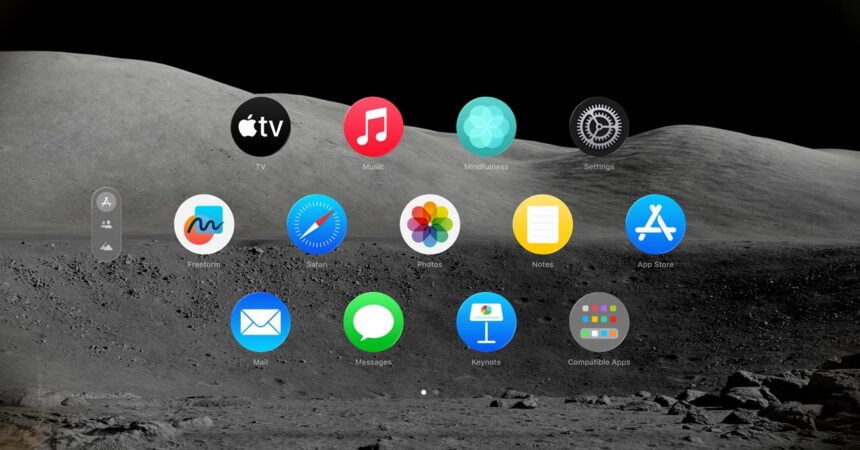Apple’s Vision Pro mixed-reality headset is coming to the real world on February 2, and all the previews so far have shown it to be a great bundle of contradictions. It’s capable but clunky. Mobile but tethered to a battery pack. Exciting but just so, so expensive.
Perhaps most importantly, it’s a device Apple touts for its software potential, but the demonstrations the company has given of the Vision Pro so far reveal that it will feature a small number of compatible apps at launch. That’s a big deal for an Apple product, whose predecessors—like the iPhone—owe a lot of their success to the app ecosystems that have blossomed around them.
“It’s amazing tech, but it’s also very clearly a development kit,” AR/VR developer Brielle Garcia said in an email to WIRED about the Vision Pro. “The price is way too high for consumers, and there’s no real killer apps for them yet.”
The Vision Pro costs $3,499 for the base model, and that’s excluding add-ons like prescription lenses or a carrying case. And even though the Vision Pro is highly anticipated, it’s entering a sagging market for VR headsets. It’s also arriving at a time of bad blood between Apple and its developers, with the company hiking up fees for out-of-app purchases. All this creates an unwelcoming environment for Vision Pro apps.
One developer, who asked not to be named out of concern that Apple might blacklist his company, says the excitement of developing something for the Vision Pro slipped away after realizing the device’s limitations. “This is the headset we’ve been waiting for for a long time. Once the glow wore off, I mean, we had a lot of questions.”
It didn’t help that, in their experience, Apple wasn’t exactly encouraging developers to dive in. Where other companies will try to entice developers onto their platforms, Apple’s approach has been “almost the opposite,” the developer says. “They want us to jump through a lot of hoops to even just be in the conversation of maybe being able to develop this kind of thing.”
Apple has not responded to a request for comment about apps on the Vision Pro.
“Any developer going into working with the Vision Pro will have known what they’re signing up for,” says Leo Gebbie, Principal Analyst of connected devices at the consumer research firm CCS Insight. He says Apple has a track record of being very involved in quality control with apps, especially on new hardware. “They’re basically giving them this brand new tool with a whole host of rules and regulations about how they want people to build the application. And Apple is even being prescriptive about how they want people to talk about the applications. They’re essentially saying, please build for our hardware, which is probably going to sell in very limited numbers.”
Developers, Gebbie says, are then faced with the dilemma of investing considerable time, effort, and money to develop an app for an audience that’s, at least for the foreseeable future, quite small.
Michael Gartenberg, a technology analyst and former director of marketing at Apple, worries the Vision Pro may be a rare misstep by the company. At its high price, this first version of the Vision Pro is clearly meant for developers, but Apple doesn’t seem keen to soften its approach enough to draw them in. “Developers are make-or-break, and I don’t see developers coming out of the woodwork,” Gartenberg says. “At this point, Apple may find itself in a position where it really needs developers more than they need Apple.”
Garcia says more apps will likely come, but not quickly.
“It will be a while before there will be a sustainable ecosystem for the Vision Pro, and I think that’s giving more developers a wait-and-see approach,” Garcia says. The headset’s high cost coupled with Apple’s standoffishness may mean the first iteration of hardware is geared toward bigger companies and enterprise applications. With time, the device and app environment should both become more accessible.
“I think the apps we will start seeing built this year will absolutely shine on the more affordable hardware for consumers that we’ll see down the road,” Garcia says.
Now though, Gartenberg says, it’s time for Apple to start evangelizing the platform to its developers.
“Apple has a lot of sway,” he says. “They could really push developers in a positive way to make sure that there was stuff coming. And none of the things that are happening bode well for Vision Pro.”
The Vision Pro will ship with a native operating system called visionOS, which comes loaded with some experiences unique to the headset: a virtual workspace where users can type documents, chat, and browse the web; a tool that switches between photorealistic virtual environments; a photo and video browser; and a 3D modeling tool.
TikTok says it’s planning an app for visionOS. And one of the more compelling native experiences for those who’ve tried it has been watching 3D movies in an app Disney created for the device. It’s the only third-party video player that’s been demonstrated at this point, and Netflix has gone out of its way to declare that its app will not in fact be on Apple’s headset.
So far, the Apple Vision Pro seems to be great for watching movies and browsing the web—both of which you’ll be doing alone if you buy one. Gebbie says Apple has made some effort to reduce the social boundaries on the Vision Pro, implementing features that let the wearer interact with the world around them. Features like video passthrough and an (kind of creepy) eyesight setting that mimics footage of the wearer’s eyeballs may help people communicate around them, but no matter what, they’re still wearing a bulky headset.
“For a company that has done an awful lot of bringing people together with things like the iPhone, this is an isolationist device,” Gartenberg says.


